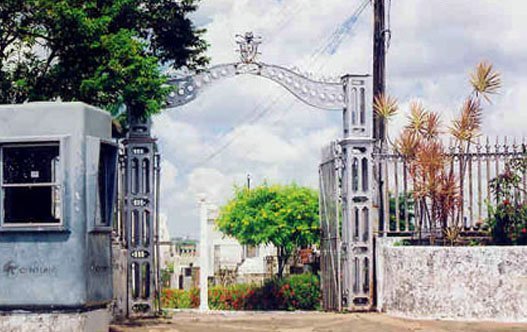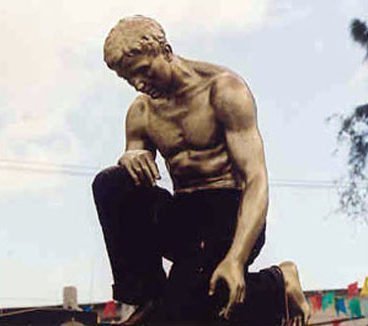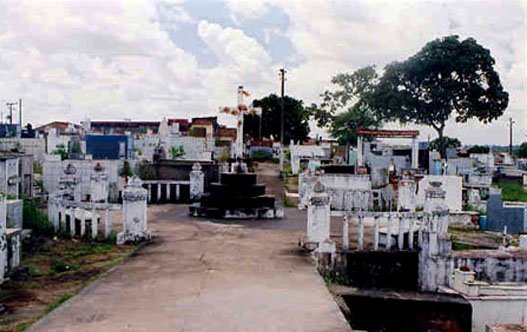Cemitério São Pantaleão
São Luís (Maranhão – MA)
São Luís (Maranhão – MA)
The city of St. Louis (São Luís) was founded by the French, then invaded by the Dutch and finally colonized by the Portuguese. The result was a unique blend of influences that created an historical mosaic like few others in Brazil. Recognized by UNESCO (The United Nations Educacional, Scientific and Cultural Organization) as Patrimony of Humanity, this city is an open-air museum, a trip back to the past, and certainly a memorable walk. Until the end of the last century, St. Louis was called the Brazilian Athens, thanks to the high cultural level of its population. As a legacy from the strong Portuguese colonization it keeps the largest existing Portuguese colonial architecture in Brazil. There are more than 3500 constructions built during the 18th and 19th centuries in the historical side of the city. The first cemetery of St. Louis, according to the European standards of burying next to churches, was established by the Brotherhood of Mercy which was responsible for giving support to the sick and also for the burials of blacks, slaves, poor people and the ones who were condemned to death, since 1623.
The burials of traders and people who had administrative power, were done inside the churches, or in its surroundings. From the 19th century on, there was a succession of buildings of cemeteries in the city, managed by religious orders and the municipality. Only after the Proclamation of the Republic there was the obligatoriness of the secularization of cemeteries, was made mandatory, then the government took over definitely the Cemetery of the Falcon (Cemitério do Gavião) (1855), officially the Cemetery of St. Pantaleão. The Saint Pantaleão Cemetery can be considered an example of “an open-air Museum”. There we find the St. Joseph Chapel, a series of sculptures in marble of Carrara originated from the Neoclassical, Realism, Art Nouveau and Art Dèco styles. The mindful tourist should visit it to find out how the funerary art belonging to this place can help us to understand our own existence in life.

The Cemetery of the Falcon – “Cemitério do Gavião”, officially the Cemetery of Saint Pantaleão, was installed at the end of the Walk Street – “Rua do Passeio” – in the neighborhood of the Farm of the Falcon – “Quinta do Gavião”. Inside of it there is the Saint Joseph Chapel which has lateral ossuaries. On the triangular fronton of its facade there are three surmounted sculptures: the charity, the faith and the hope – which are the symbols of mercy. One can notice that it has been enlarged during the last years. The last restoration was in 1997 by the Municipal Department of Landing, Housing and Urbanization. We can highlight the richly decorated ossuary, set on the inner side of the wall that leads to Rua do Passeio – Walk Street. The wall of the cemetery is interspersed with cast iron bars and pillars meant to improve its internal visibility.

By visiting the Cemetery of Saint Pantaleão, people can know much about the history of the state of Maranhão and visitors are also able to admire the artwork from local artisans and sculptors. Among the famous people buried in the cemetery we highlight the families: Coutinho de Vilhena, Jose Tinoco Pereira, Marcelino Gomes de Almeida, Almir Feres, Martins Pereira, Antônio José Maria, Belfort Nunes, Dr. Benedito Pereira, Homem de Carvalho Martins , Moraes Rego, Almir Panga Nina, Carneiro Oliveira, Moreira Lima.

This conventional secular cemetery has the particularity of being founded by the Brotherhood of Mercy in 1855 – New Cemetery of Mercy . After the Proclamation of the Republic, it became secularity, it means, administered by the City Hall. In 1953 it was officially named Cemetery of Saint Pantaleão; however the local people still refer to it as the “Cemetério do Gavião”- The Falcon´s Cemetery – a link with the neighborhood where it is based.



Cemetery is a cultural institution of the Western society. The preservation of its heritage is one way to legitimize it, as well as artistics and cultural activities carried on in situ.
+ 55 62 3225 5957 | + 55 62 996 143 427
E-mail: maelizia@terra.com.br

 Cemitério Campo Santo
Cemitério Campo Santo 



